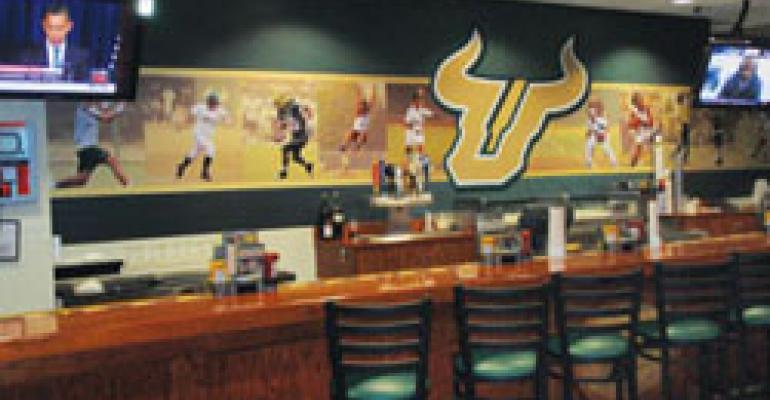Over the past 11 years, Beef ‘O’ Brady’s president Nick Vojnovic built his family sports pub chain by moving into distressed locations. That strategy helped the Tampa, Fla.-based company quickly grow to 263 franchised locations throughout the country.
As the credit market tightened last year, though, Vojnovic found it difficult to find mom-and-pop operators able to secure the $450,000 needed to open a new Beef ‘O’ Brady’s. Nonetheless, he’s found a bonanza in new opportunities that are exposing his brand to thousands of customers in new venues. Just in the past five months, Beef ‘O’ Brady’s has started moving into nontraditional sites, including a college campus, a resort and a hotel.
“At the University of South Florida, we’re getting exposure to 60,000 students,” Vojnovic says. “The TradeWinds [Island Grand Resort in St. Petersburg, Fla.] has 1 million visitors a year, and the Best Western [Hotel and Conference Center in Brandon, Fla.] is in an industrial-car dealership location that’s giving our family-style restaurant exposure to a different customer.”
Beef ‘O’ Brady’s is not alone in its strategy to open in non-traditional sites as a result of the financial difficulties gripping the nation. Chili’s has built a presence in airports, while T.G.I. Friday’s opened four casino sites in late 2008. Others brands such as Friendly Ice Cream Corp. are exploring or creating streamlined prototypes that allow them to expand and reach new markets without the large price tag of a traditional location.
“At the core, smaller nontraditional sites allow you to increase the number of units and outlets,” says Darren Tristano, executive vice president of Technomic Inc., a Chicago-based industry research firm. “If Krispy Kreme looked at Dunkin’ Donuts a little more closely, maybe they would have created 1,000-square-foot platforms instead of building huge stand-alones that have ultimately been closed.”
The more broadly you can spread your brand while forcing costs down, the more successful you can be, he adds.
While many operators are looking at smaller sites, some are going in the opposite direction. Brad Honigfeld, chief executive of Briad Restaurant Group, LLC, the Livingston, N.J.-based T.G.I. Friday’s franchisee, isn’t creating smaller footprints. The four new Las Vegas casino locations opened at the end of 2008 are larger than average, with 300 to 450 seats.
Honigfeld hopes to duplicate the success he’s seen at the company’s first casino, The Orleans Hotel and Casino, which has become one of the top revenue producers among his 70 T.G.I. Friday’s locations and among all 610 Friday’s in the United States.
“The new restaurants are in prime locations, literally on the casino floor where people are playing blackjack,” he says. “We’re replacing old coffeehouses that really had no brand names and were money losers. We’re meeting guests’ expectations with a good quality branded product.”
That pleases casino operators, who are doing anything they can to keep guests on premise, he says.
Beef ‘O’ Brady’s Vojnovic has found he’s filling a similar desire of his hotel and resort partners, who also want to keep customers on site.
“There’s no doubt that having branded foodservice in airports, campuses and hotels drives sales compared to an unbranded property,” he says.
At the same time, he adds, these non-traditional sites “offer us a great opportunity to build our brand and allow us to gain an advantage during this economic downturn with some folks that can give us some extra exposure.”
These new sites aren’t without challenges, operators observe. Vojnovic says working with hotels means dealing with a large number of operators who hold one or two properties. Honigfeld also has found himself in the breakfast business at two of his casino locations, which have led to new menu items and serving breakfast all day long rather than just in the morning.
“We’ve also found we have to gear ourselves for casino occupancy fluctuations better,” he says.





